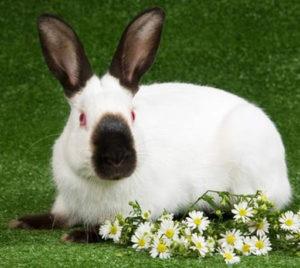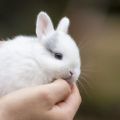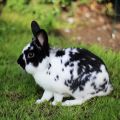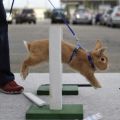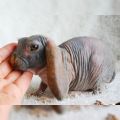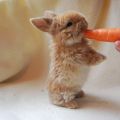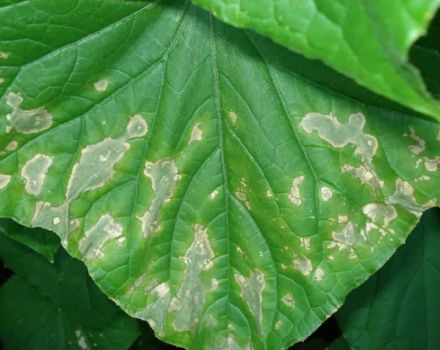Description and characteristics of the lion-headed rabbit breed, rules of care
The lion-headed miniature rabbit is an amazing creature. It is difficult to remain indifferent when looking at a miniature animal figurine. Memories of favorite children's toys and heroes of fairy tales come to mind. In addition to the adorable appearance, the pet has a friendly character and ebullient energy. The maned animal will become a friend for all family members.
Origin story
The history of the birth of the lion-headed rabbit breed is somewhat confusing. According to one version, the first maned animals appeared randomly, as a result of a genetic mutation.
Other experts argue that the unusual animals appeared in the late 20th century thanks to Belgian breeders. As a result of crossing the Belgian dwarf rabbits and representatives of the Swiss fox breed, an unusual maned offspring were born.
Due to the peculiarities of the external appearance, the animals received a witty name - the lion's head.
The charming creatures instantly became popular in Europe. The breed received real recognition in 2002. Thanks to British specialists, the breed has gained official status. On the territory of Russia, lion-headed rabbits were recognized by the Union of Breeders only in 2010.
Description of the lionhead breed
The animal has a non-standard appearance. Its short, muscular body blends harmoniously with straight, strong legs. The hind legs are symmetrical to the well-developed shoulders. The round head, topped with short erect ears, smoothly merges into a compact body. The neckless illusion makes the pet look like a fun toy. The color of the bright, wide-set eyes matches the color of the animal.
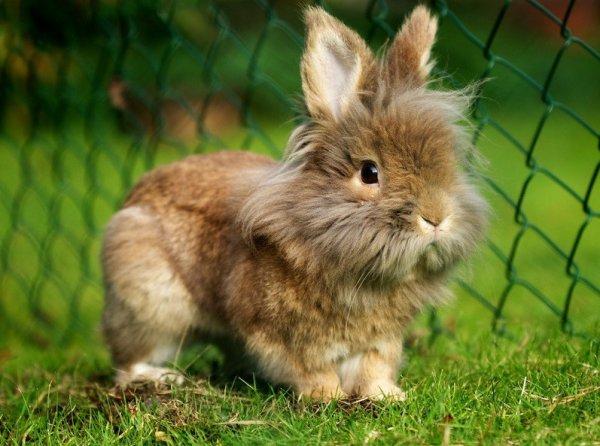
The dwarf rabbit weighs only 1.5-1.7 kg. Small size and adorable muzzle enhance the similarity of the animal with a plush hare. The neck and head of the animal are buried in a luxurious mane. Sinking down on the chest of a handsome man, the vegetation forms a decorative triangle. The soft, fluffy rabbit coat can be dyed in different colors. Chinchilla, lilac, blue colors are popular. Orange, opal or tortoiseshell suits look spectacular.
An animal's mane is of 2 types:
- Single. In this case, the main decoration of the pet looks modest. Vegetation is scarce, rare strands disappear over time.
- Double. A thick, dense mane forms a border with the animal's main coat.
The type of pet's mane depends on the rabbit inheriting a certain number of genes responsible for the lion's effect. You can determine whether a long-eared pet belongs to one of the groups at an early age of the animal. Owners of a single type of mane overgrow like ordinary rabbits, while shaggy pets are covered with long hair unevenly. First of all, the strands grow on the head and in the back of the rabbit. The eared pet lives in love and care for up to 10 years. The rabbit readily responds to affection and literally languishes in an atmosphere of loneliness and stress.

Main pros and cons
Despite the abyss of charm, the lion-headed rabbit has not only a lot of advantages, but also some disadvantages. Among the pluses:
- The complaisant, affectionate disposition of the pet turns communication with the animal into a sheer pleasure.
- The rabbit does not need complicated care.
- Due to its modest size, the pet does not take up much space and feels great in any apartment.
- The animal rarely sheds.
- The rabbit is endowed with a charming appearance, and the variety of colors allows you to choose a pet to your liking.
Negative qualities include:
- Finicky food.
- Alertness, fearfulness.
- Difficult adaptation to new conditions of detention.
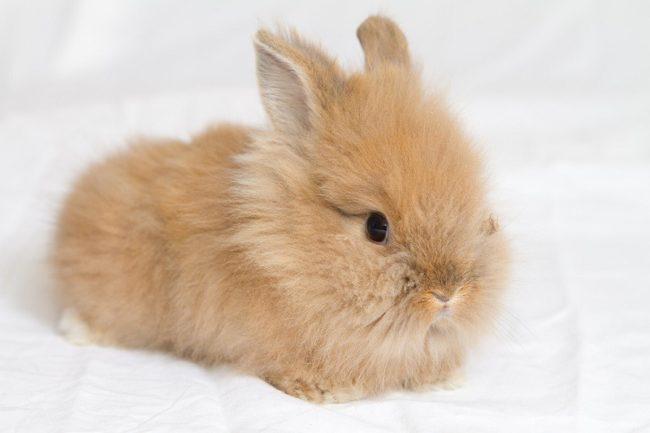
Rules for keeping and caring for animals
Despite the fact that the animal needs daily walks, the rabbit is in its own house most of the day. Therefore, for an eared pet, you need to prepare a spacious cage. An apartment with an area of 70 * 80 * 100 cm is suitable for a lion-headed rabbit.
The dwelling is equipped with a convenient feeder, a drinker and a device for grinding teeth. A hypoallergenic mat is placed on the floor. The cage is placed in full view of the owners, in a place protected from drafts.
Once a week, the shaggy pet is combed out. The procedure is carried out for 20-25 minutes. Manipulation will help avoid tangles in the animal's fur. Otherwise, the rabbit pulls out the excess hair on its own. This leads to the accumulation of hairs in the pet's esophagus, and as a result - to the death of the animal. The claws are trimmed every month. The cage is cleaned regularly and the bedding is changed.
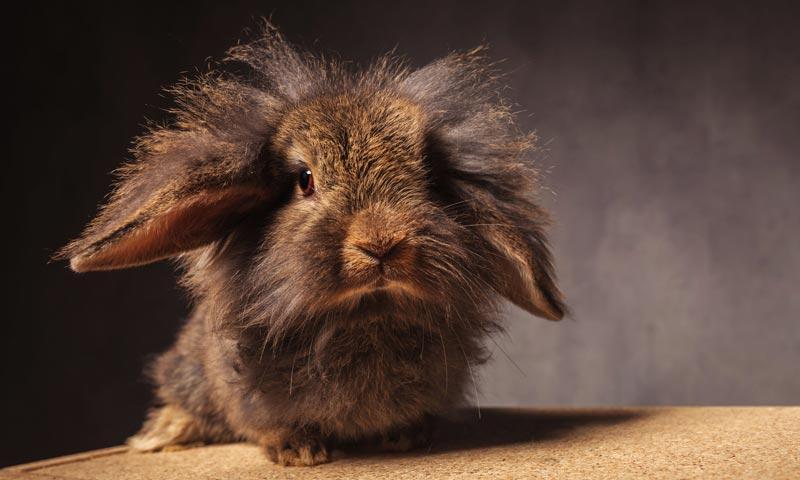
Diet
The rabbit's daily diet consists of 80% grass (plantain, burdock, dandelion, alfalfa, or clover) and 20% grains (barley, oats or wheat). In winter, instead of succulent grass, the pet is treated with hay. Fruits and vegetables are added to the animal's diet daily. The rabbit is treated with slices of pumpkin, carrot, turnip, apple or pear. For the prevention of diseases and dysbiosis, the animal is given vitamin supplements, chalk and bone meal.
Breeding lionhead rabbits
After reaching 7 months of age, the reproductive function of the female is fully formed. A healthy individual brings up to 6 rabbits. To obtain full-fledged offspring, representatives of the same breed of animals are crossed.
Preparing for breeding, the female spreads her own fluff in the corners of the cage. After mating, the pregnant rabbit is transferred to enhanced nutrition. The animal needs a lot of drinking water, so the drinker must be constantly filled. Otherwise, the female will eat the newborn rabbits.
After birth, the offspring remains with the mother. You cannot move the newly-appeared family anywhere. For a month, the rabbits have enough nutrition in the form of mother's milk. Then, a small amount of compound feed is gradually introduced into the diet of animals.
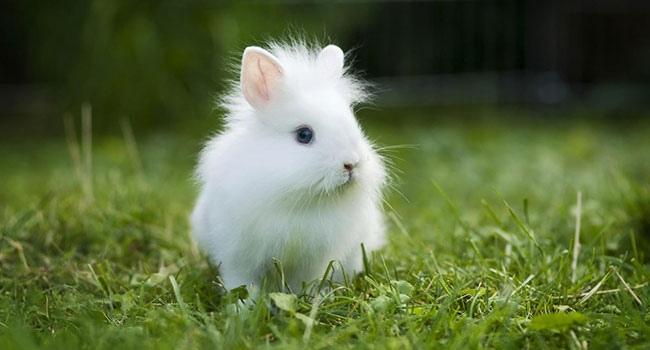
Possible diseases and prevention from them
Rabbits often suffer from the stress they endure. The reason may be loud noises, aggressive behavior of a domestic cat or improper handling of the owners. The frightened pet is overcome by diarrhea. Within a day, the rabbit's health returns to normal.
Ailments such as stomatitis, scabies, pneumonia, or constipation threaten serious consequences.Inflammatory processes in the eye area and urinary dermatitis turn into troubles.
Gastrointestinal stasis is especially dangerous. The disease is expressed in violation of the intestinal motility of the animal. In this case, the pet needs emergency help from a veterinarian-ratologist. For the prevention of diseases, a handsome eared man is vaccinated annually.
How to choose and how much does it cost?
Choosing a lion-headed rabbit is a responsible business. A frivolous approach often leads to the purchase of an unviable animal. A healthy pet has a thick, long, shiny mane. Vegetation beautifully frames the rabbit's head without covering its eyes and nose. The ears are upright, the eyes and nose are clean. The rabbit's well-being is evidenced by the pet's active behavior and curiosity.
Serious disadvantages of the animal include:
- thinness;
- too long ears (more than 9 cm);
- narrow body;
- low stand;
- dull coat.
A little rabbit is purchased as a pet. The cost of an animal ranges from 2,000 to 3,000 rubles. To participate in professional exhibitions, it is better to buy an adult rabbit. An elite pet will cost the owners 7,000-10,000 rubles.

